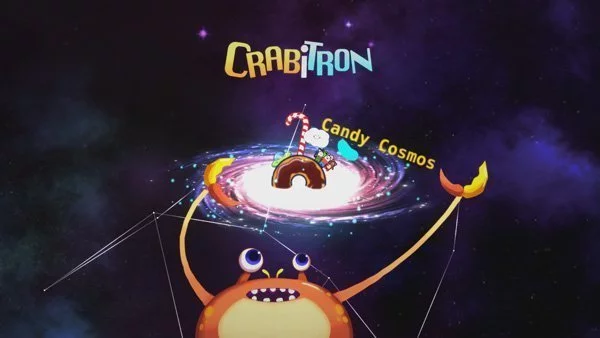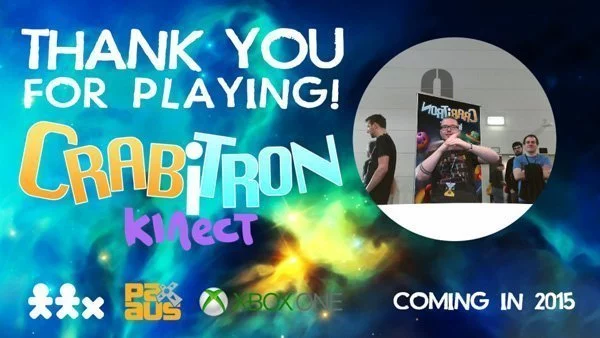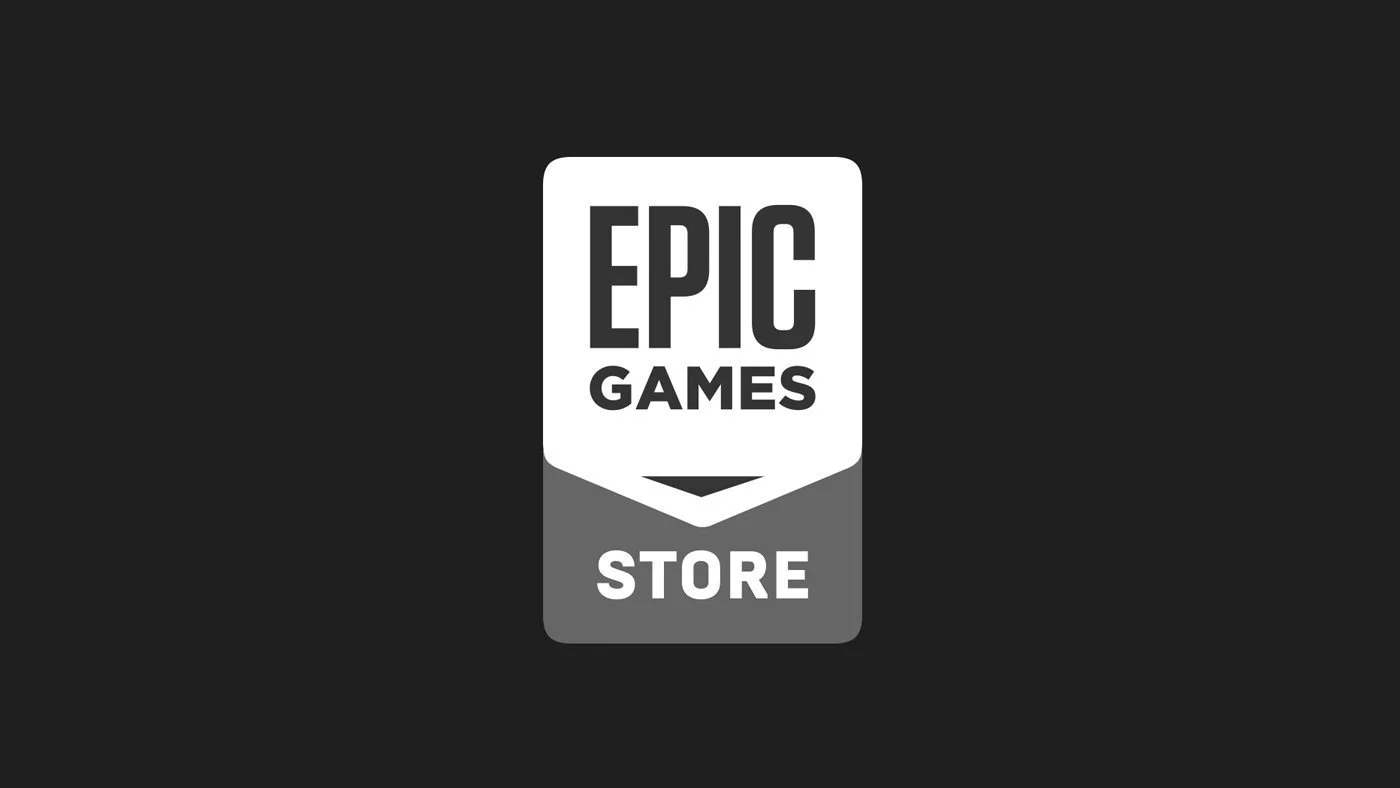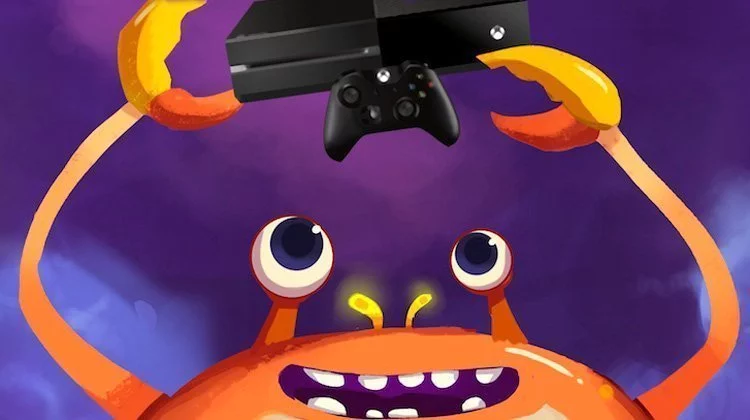One of the breakout indie stars of last year’s PAX Australia, Crabitron was an iOS title that tried something different with the system’s multi-touch capabilities. This year, Two Lives Left have returned to the showfloor with the game’s next evolution – Crabitron Kinect. We pinched a few minutes with John Millard, the game’s designer, to discuss what the move to motion controls has been like.
Matt Gosper, Stevivor: For anyone who hasn’t seen or played the game before, can we start with the elevator pitch for the game’s concept?
John Millard: Sure! Crabitron Kinect is a game about an adorably mutated giant space crab, with your body as the controller. You go around the universe destroying and eating everything.
Stevivor: Fantastic. And a little about the team behind the game (Two Lives Left)?
Millard: We’re a small independent video game developer, we’re all from Adelaide. I’m working on the game as programmer and designer, Simeon is doing art and Amelia is doing the producing, scheduling and business development stuff.
Stevivor: Now the game started as an iOS game on the iPad, what was behind the decision to move to Kinect as the next stage?
Millard: Last year we brought it to PAX Australia, and a lot of people gave us the feedback saying that it might be really cool on Kinect. We remembered thinking about that early on when we were developing the original, but the 360 was too hard for us to develop for in terms of our resources and the requirements for certification. Then ID@xbox came out with the Xbox One, and everything started aligning with what we needed to make the game – so we decided to go for it.
Stevivor: And has the Kinect edition been in development since PAX last year?
We started about six months ago, it took a while for us to get dev kits and get all the legal paperwork sorted out, but once we got that done we started work on the game.

Stevivor: In moving to Kinect, what were the major challenges around changing the method of interaction?
Millard: One of our main challenges is that you can’t feel anything, there’s no tactile sensation from touching stuff but you want people to feel like there is. So we added a visual skeleton in the background, and we have this thing where it sort of normalises the player’s body size no matter how big or small they are – you can always reach every part of the screen. That was one of the main things. We also made our own new computer vision algorithm that detect the claws, so it feels as fluid and responsive as possible.
Stevivor: What was the major challenge of adapting to motion control?
Millard: The major challenge is that you don’t have that tactile sensation, and the other thing is that the data you get [from the camera] can be a bit noisy. The idea is to try and make it as precise as possible but at the same time you’re just moving your hands in the air. So giving that as much feedback, giving people this fun feeling of movement… And part of that is the way the crab follows you wherever you go, and the way your arm’s 1-to-1 with the screen, it’s not gestures. We decided to go with completely visceral controls so you do what you want to happen, and it just happens.
Stevivor: Were there any new gameplay elements you developed as part of the Kinect version, or that emerged from developing for the Kinect?
Yeah, with the iPad version it was like an endless crabber game where you destroy spaceships and avoid enemies. We went with a really different approach here, crafted levels, worlds, themes and all these different hand-crafted bits that go together. When you go to a level, the level experience is completely designed from start to finish instead of a procedural, endless game. We decided to do that with the Kinect version to make it a more premium experience.
Stevivor: Do you find with the 1-to-1, visceral controls as you put it, that people tend to ‘get’ the concept faster?
I’d say it’s around half the time to understand the controls compared to the iPad game. The only thing I tell people when they have a go is that I show them what I do with my hands or I say, “Imagine you’re holding a giant hamburger”, and they tend to get it after that. The game auto-compensates when people try stuff so when it doesn’t or does work, it reinforces the game automatically.
Stevivor: With the Kinect, what kind of new content is coming to this edition of the game?
We’re looking to have six worlds and thirty levels in total. Each world is themed differently and the idea is that we’ll have these things called kinetic puzzles. In the demo here at PAX you can see you have to open a gate by rotating a wheel, or you have to destroy a meteor by hitting its weak spots. That’s all part of this kinetic puzzle idea, you solve the puzzle through movement, not arbitrary abstractions with buttons and unrelated things.
Stevivor: Did you find along the way there were any surprises in developing this game, anything you didn’t expect?
There were a lot of things like that. Initially I thought the Kinect controls would be harder than they were, but then other parts of the Kinect were a lot easier than I thought they’d be as well. It was a bit of a mismatch between what I thought would be hard and easy. One specific thing was that I thought the hand controls would be easy – the Kinect supplies hand-states and orientations for joints. It turned out to be not what we needed, it was really imprecise or slow, so we had to rewrite those algorithms ourselves from scratch.

Stevivor: Is it primarily the Kinect you’re aiming for with this, or any other motion control formats?
Initially it’s going to be just out on the Xbox One, but later on we may consider other platforms. It really just depends on how the game goes and how it’s perceived. Obviously if it bombs on Kinect I would probably say it’s less likely, but if it’s really successful it’s more likely! Really depends on our strategy at that point.
Stevivor: At this stage, what’s the release window for Crabitron Kinect?
We’re looking at E3 2015 as our launch target.
Stevivor: Just finally, is there any one feature or little hidden function of the game you’d like to point out to people?
Sure, one of the things you can do that’s not immediately obvious is that there’s this big candy snake that comes along. If you grab it by the tail it’s actually a dangerous weapon – you can whip and kill enemies with it. Meteors keep coming and you can keep whipping them back and forth like a big, big nunchuk.
Stevivor: Very nice! Thanks for your time.
This article may contain affiliate links, meaning we could earn a small commission if you click-through and make a purchase. Stevivor is an independent outlet and our journalism is in no way influenced by any advertiser or commercial initiative.
























